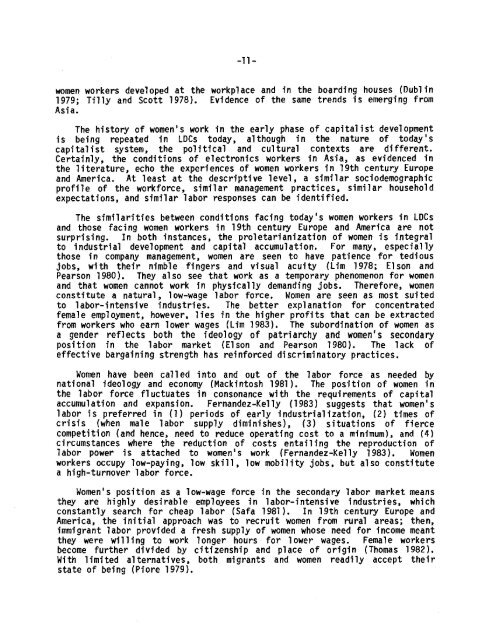Health, Women's Work, and Industrialization - Center for Gender in ...
Health, Women's Work, and Industrialization - Center for Gender in ...
Health, Women's Work, and Industrialization - Center for Gender in ...
Create successful ePaper yourself
Turn your PDF publications into a flip-book with our unique Google optimized e-Paper software.
-11-<br />
women workers developed at the<br />
1979; Ti lly <strong>and</strong> Scott 1978).<br />
Asi a.<br />
workplace <strong>and</strong> <strong>in</strong> the board<strong>in</strong>g houses (Dubl <strong>in</strong><br />
Evi dence of the same trends is emergi ng from<br />
The history of women's work <strong>in</strong> the early phase of capitalist development<br />
is be<strong>in</strong>g repeated <strong>in</strong> LDCs today, although <strong>in</strong> the nature of today's<br />
capitalist system, the political <strong>and</strong> cultural contexts are different.<br />
Certa<strong>in</strong>ly, the conditions of electronics workers <strong>in</strong> Asia, as evidenced <strong>in</strong><br />
the literature, echo the experiences of women workers <strong>in</strong> 19th century Europe<br />
<strong>and</strong> America. At least at the descriptive level, a similar sociodemographic<br />
profile of the work<strong>for</strong>ce, similar management practices, similar household<br />
expectations, <strong>and</strong> similar labor responses can be identified.<br />
The similarities between conditions fac<strong>in</strong>g today's women workers <strong>in</strong> LDCs<br />
<strong>and</strong> those fac<strong>in</strong>g women workers <strong>in</strong> 19th century Europe <strong>and</strong> America are not<br />
surpris<strong>in</strong>g. In both <strong>in</strong>stances, the proletarianization of women is <strong>in</strong>tegral<br />
to <strong>in</strong>dustrial development <strong>and</strong> capital accumulation. For many, especially<br />
those <strong>in</strong> company management, women are seen to have patience <strong>for</strong> tedious<br />
jobs, with their nimble f<strong>in</strong>gers <strong>and</strong> visual acuity (Lim 1978; Elson <strong>and</strong><br />
Pearson 1980). They also see that work as a temporary phenomenon <strong>for</strong> women<br />
<strong>and</strong> that women cannot work <strong>in</strong> physically dem<strong>and</strong><strong>in</strong>g jobs. There<strong>for</strong>e, women<br />
constitute a natural, low-wage labor <strong>for</strong>ce. Women are seen as most suited<br />
to labor-<strong>in</strong>tensive <strong>in</strong>dustries. The better explanation <strong>for</strong> concentrated<br />
female employment, however, lies <strong>in</strong> the higher profits that can be extracted<br />
from workers who earn lower wages (Lim 1983). The subord<strong>in</strong>ation of women as<br />
a gender reflects both the ideology of patriarchy <strong>and</strong> women's secondary<br />
position <strong>in</strong> the labor market (Elson <strong>and</strong> Pearson 1980). The lack of<br />
effective barga<strong>in</strong><strong>in</strong>g strength has re<strong>in</strong><strong>for</strong>ced discrim<strong>in</strong>atory practices.<br />
Women have been call ed <strong>in</strong>to <strong>and</strong> out of the 1 abor <strong>for</strong>ce as needed ~y<br />
national ideology <strong>and</strong> economy (Mack<strong>in</strong>tosh 1981). The position of women 1n<br />
the 1 abor <strong>for</strong>ce fl uctuates <strong>in</strong>consonance wi th the requi rements of capital<br />
accumul ati on <strong>and</strong> expansi on. Fern<strong>and</strong>ez-Kelly (1983) suggests that women's<br />
labor is preferred <strong>in</strong> (1) periods of early <strong>in</strong>dustrialization, (2) times of<br />
crisis (when male labor supply dim<strong>in</strong>ishes), (3) situations of fierce<br />
competition (<strong>and</strong> hence, need to reduce operat<strong>in</strong>g cost to a m<strong>in</strong>imum), <strong>and</strong> (4)<br />
circumstances where the reduction of costs entail <strong>in</strong>g the reproduction of<br />
labor power is attached to women's work (Fern<strong>and</strong>ez-Kelly 1983). Women<br />
workers occupy low-pay<strong>in</strong>g, low skill, low mobility jobs, but also constitute<br />
a high-turnover labor <strong>for</strong>ce.<br />
<strong>Women's</strong> position as a low-wage <strong>for</strong>ce <strong>in</strong> the secondary labor market means<br />
they are highly desirable employees <strong>in</strong> labor-<strong>in</strong>tensive <strong>in</strong>dustries, which<br />
constantly search <strong>for</strong> cheap 1 abor (Safa 1981). In 19th century Europe <strong>and</strong><br />
America, the <strong>in</strong>itial approach was to recruit women from rural areas; then,<br />
immigrant labor provided a fresh supply of women whose need <strong>for</strong> <strong>in</strong>come meant<br />
they were will<strong>in</strong>g to work longer hours <strong>for</strong> lower wages. Female workers<br />
become further divided by citizenship <strong>and</strong> place of orig<strong>in</strong> (Thomas 1982).<br />
With limited alternatives, both migrants <strong>and</strong> women readily accept their<br />
state of be<strong>in</strong>g (Piore 1979).




